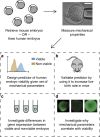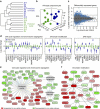Human oocyte developmental potential is predicted by mechanical properties within hours after fertilization
- PMID: 26904963
- PMCID: PMC4770082
- DOI: 10.1038/ncomms10809
Human oocyte developmental potential is predicted by mechanical properties within hours after fertilization
Abstract
The causes of embryonic arrest during pre-implantation development are poorly understood. Attempts to correlate patterns of oocyte gene expression with successful embryo development have been hampered by the lack of reliable and nondestructive predictors of viability at such an early stage. Here we report that zygote viscoelastic properties can predict blastocyst formation in humans and mice within hours after fertilization, with >90% precision, 95% specificity and 75% sensitivity. We demonstrate that there are significant differences between the transcriptomes of viable and non-viable zygotes, especially in expression of genes important for oocyte maturation. In addition, we show that low-quality oocytes may undergo insufficient cortical granule release and zona-hardening, causing altered mechanics after fertilization. Our results suggest that embryo potential is largely determined by the quality and maturation of the oocyte before fertilization, and can be predicted through a minimally invasive mechanical measurement at the zygote stage.
Figures





References
-
- Mtango N. R., Potireddy S. & Latham K. E. Oocyte quality and maternal control of development. Int. Rev. Cell Mol. Biol. 268, 223–290 (2008). - PubMed
-
- Stitzel M. L. & Seydoux G. Regulation of the oocyte-to-zygote transition. Science 316, 407–408 (2007). - PubMed
-
- Bouniol C., Nguyen E. & Debey P. Endogenous transcription occurs at the 1-cell stage in the mouse embryo. Exp. Cell Res. 218, 57–62 (1995). - PubMed
-
- Dobson A. T. et al.. The unique transcriptome through day 3 of human preimplantation development. Hum. Mol. Genet. 13, 1461–1470 (2004). - PubMed
Publication types
MeSH terms
LinkOut - more resources
Full Text Sources
Other Literature Sources
Molecular Biology Databases

